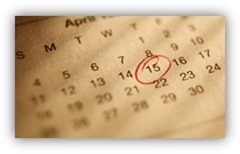Tip o’ the Week #150 – It’s a date!
 Some tweaks and tips are basically not all that exciting unless you find they solve a problem you’ve had to deal with directly, maybe on a number of occasions, at which point they’ll transform to being a miraculous time saver that you’ll continue using for years to come. One such example, is the Copy As Path trick in Windows Explorer.
Some tweaks and tips are basically not all that exciting unless you find they solve a problem you’ve had to deal with directly, maybe on a number of occasions, at which point they’ll transform to being a miraculous time saver that you’ll continue using for years to come. One such example, is the Copy As Path trick in Windows Explorer.
Date and time functionality in applications is a particularly humdrum area to go looking for life-changing solutions, but it’s one that we all deal with a lot, perhaps subconsciously. We’ve covered date stuff before in Tip o’ the Week - #104, #102 and others.
Windows 8 – where’s the clock?
One of the strangest things to get used to in the Windows 8 world, is there’s no clock visible for most of the time – whether you’re used to the Date/Time display from the System Tray or if you’re still missing the Vista-era clock desktop gadget, the simple fact is that when you look at the start menu, and when you’re in the vast majority of full-screen Modern UI applications, there’s nothing telling you the time. Is it a bit much to have to switch to the old fashioned Desktop (press WindowsKey+D) , just to see what the time is?
 Fortunately, there are Apps which can solve this annoyance. There’s a free one that’s just a simple live tile showing The Time, or if you’re a jet set type who needs to know the time in different parts of the world, what about a World Time app that scrolls between all the places you list?
Fortunately, there are Apps which can solve this annoyance. There’s a free one that’s just a simple live tile showing The Time, or if you’re a jet set type who needs to know the time in different parts of the world, what about a World Time app that scrolls between all the places you list?
Tickety-boo.
Some date shortcuts
Did you know that if you’re using OneNote, and you press ALT+SHIFT+”D”, it will insert the date in whatever you’re editing – handy if you collect notes about a particular subject all in one page, but you want to annotate when you did something or spoke to someone. If you’re particularly time critical, press ALT+SHIFT+”T” and it’ll insert the current time too. The same tricks work in Word, and when you’re writing an email in Outlook, too.
If you live your life in Excel, then CTRL+”;” inserts the date and CTRL+”:” pastes the time – again, useful if you’ve got columns in your sheet about when you last called that contacts etc. Of course, you should be using CRM, not a spreadsheet; tsk tsk.
Outlook and its dates
Way back in the mists of time, 130 weeks ago if the numbering of ToW was consistent (which it’s not, quite) , there was a tip about Outlook dates, but I bet most of you weren’t reading then, and if you were, well, you’ve probably forgotten.
 In a nutshell, ever since Outlook 97 was released, it’s had some smarts built into every date field that you can edit without using a date picker – you know, date fields on appointments, Tasks, reminders etc. Instead of just picking the date from a calendar, you could enter it “9-11-12 or 9/11/2012 or 9 Nov, would all resolve to the right date (well they would if you have your system date formats set to the UK one…)
In a nutshell, ever since Outlook 97 was released, it’s had some smarts built into every date field that you can edit without using a date picker – you know, date fields on appointments, Tasks, reminders etc. Instead of just picking the date from a calendar, you could enter it “9-11-12 or 9/11/2012 or 9 Nov, would all resolve to the right date (well they would if you have your system date formats set to the UK one…)
You can also enter real expressions, like tomorrow, 3 weeks, this Sunday, next Friday, Christmas Eve. Not dates that change – like Easter Sunday, or Thanksgiving day, though there are some static “holiday” dates such as Lincoln’s Birthday, Halloween, New Year’s Day etc. Have a go, it’s really rather useful
Comments
- Anonymous
January 01, 2003
Useful info, thanks!